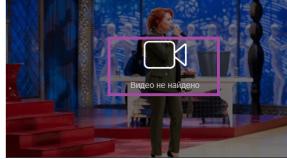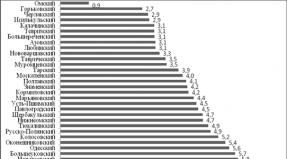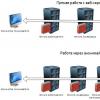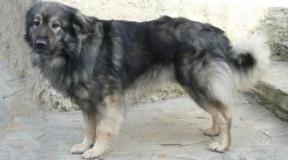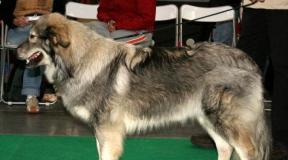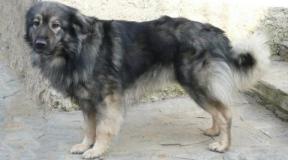Didactic games to develop speech 6 years. Didactic games. The game "Who was
The peculiarities of the mental development of children of the seventh year of life are their increased abilities for more in-depth analysis and synthesis: the ability to allocate both general and individual signs of objects and phenomena, compare them on various features, to make generalizations, express judgments, conclusion. Six-year-old children show great interest in teachings, desire to learn at school.
But in training, raising six-year children, the game method is still important. This is also evidenced by many years of experience with the six-year-old children, described by S. A. Amonashvili in his interesting book "Hello, Children!", And scientific research in this area.
Guiding the didactic games of children of six years, the educator relies on their age characteristics. More often, games in which children learn to have a secret and consistently express their thoughts, expressively tell, in which mathematical representations are developing, the ability to auditory speech analysis, intelligence, excerpt, will.
The role of leading in games of children 6 - 7 years is more common to someone from those involved, they are more independent in choosing the didactic games, the organization of the situation, the selection of partners in the game. The tutor follows the players, acts in case of need as a counselor, a fair judge during independent gaming of children.
As a game method of learning, the didactic game is used in all classes to assimage certain methods of mental actions, systematization, clarifying knowledge of children. The initiative in the choice and the game belongs to the tutor. The content of the game and its rules are subject to educational and educational tasks that advanced by the specific software requirements of this or that type of classes. These games are described in different methodological manuals on a specific section of work.
Let us dwell on the organization and management of games outside of classes. Six-year children in hours free from classes, with hobby playing and interest. But the educator can give new games if the guys have knowledge necessary for solving game tasks. For example, children like the game "On Earth, in Heaven and the Sea". But they will be able to play it if they have ideas about some of the characteristic features in the clothing of infantrymen, pilots and sailors, attributes, cars, etc.
The principles of game selection, therefore, remain constant: the availability of rules, material, the possibility of variation of tasks, emotional impact on children.
When analyzing the played game, the teacher is more noting the moral behavior of children: the ability to come to the revenue, not to brag about its success, to be patient, not to interrupt your comrade, wait until he collected with his thoughts. All this is very important for the formation of the correct behavior of children in the school lesson.
In the preparatory for school, many games described in this compilation, the educator makes up with children. In order for this work to be an effective, teacher need to know which illustrative material will be needed, and it must be gradually chosen; What items need to be done (boxes, cards, chips, etc.). This work is important in itself, since it is educated in children hard work, they develop manual labor skills, and most importantly, they form a sense of responsibility for the entrusted matter.
The role of the tutor himself, his leadership of the didactic game, is important, attitude to the game as a method of upbringing and learning children of the seventh year of life. First of all, he himself should want to play with children. Sh. A. Amonashvili writes about this: "They will laugh when I deliberately read the text and they will be instructed to detect my" errors ". And I will accept quite a serious look and insist on my own until they prove their right. They will laugh and then when I ask them to dictate your examples, which I will specially decide wrong. Finding my "mistake", they will prove with a laugh, why am I wrong<…> And how, if not in the dispute with me, experience the child a sense of joy from his intellectual victory, from the proclamation and approval of the truth! "
Experience shows that it is in such a "battle", children will most recognize the joy of knowledge; At the same time, they develop a valuable quality of the future student, personality: the ability to prove the correctness of their decision, judgment.
Through the assimilation of the game rules, and therefore, with the help of the didactic game, the educator brings children to a serious attitude to the rules and other activities: in a creative game, in labor, in class. It is impossible not to fulfill the rules - this is absorbed by children throughout their childhood. And the absorption of this is more contributing to didactic games. Already the smallest children often complain about their peers: "I will not play with him, it does not act according to the rules!" Therefore, it is so important that the caregiver is always very accurate, objectively assessed the fulfillment of the rules by each player, the whole group.
And in the preparatory school, the educator thinks over the relationship of didactic games with other types of children's activities, with creative games, labor, artistic activities. Experience shows that didactic games are one of the ways to create a gaming plan in a creative game. Items, attributes, emblems with which children get acquainted in the didactic game, they are then used in their own games. This increases the interest of children and to some classes.
During the work, the teacher also often resorts to didactic games, uniting children in the brigade, links, introducing elements of competition with summing up work. The game form of the organization of children (work in the garden, the cleaning of the group room, the manufacture of toys, etc.) makes their work more interesting, fascinating.
Older children love games in non-residents. In the course of these games, they develop a coherent, figurative speech, humor, skill to joke. These games increase the interest of children to acquire new knowledge.
Before spending the game, the educator finds out if children know that there are noby, where they heard them. Children answer that there are no fiction, the fact that there is no life in life, there are often unprecedented in fairy tales. If they can't answer, the teacher himself will tell them about it.
He offers children to tell some unprecedented fairy tales from familiar fairy tales. Children remember: "A red hat could not get out of the wolf's belly," "Geese can not be carried on the wings of Ivanushka," "Fish cannot do wonders," "the beasts do not know how to talk", etc.
When children learn to notice non-residents, the educator reads them a work with non-relieves, introduces them with an entertaining content. It happens that the guys have questions that the tutor cannot immediately give an answer, for example: whether elephants are floating whether the rocket is gasoline and so on. In such cases, he promises to tell us tomorrow and, finding out for himself that It was required, the next day necessarily gives them the correct answer. Otherwise, the guys disappears interest in such games.
When holding a game, you should not take all the work, but only part of it. Initially, the passage may contain 2 - 3 non-bullies, and then there may be more. The experience of the game shows that children can remember and call 6 - 7 of the non-residents contained in the passage. Based on this, the tutor independently breaks the work into semantic parts.
Thus, in the preparatory group, the educator actively directs the didactic game. Here the game is wider as a means of forming child communication, consolidation of norms and rules of behavior not only in the game, but also outside it, as a means of education in children interest in the phenomena of the surrounding life.
Games with items for children 6-7 years
First grader
Didactic task. Consolidate the knowledge of children about what is needed first grader to study at school; Rail a desire to learn at school, collens, accuracy.
Gaming rule. Collect objects by signal.
Gaming action. Competition - who will quickly collect in the portfolio everything is necessary for school.
Stroke Game. On the table at the tutor lie two briefcases. On other tables are educational supplies: notebooks, bucvari, pencils, handles, color pencils, etc.
After a brief conversation that children prepared for school of the group will soon go to school and that they themselves will assemble in the portfolios everything you need to study, they start the game: they go to the table two players; By team type, they must select the necessary training supplies, gently put them in the portfolio and close it. Who will make it first, he won. To the game continue, children who completed the task choose other participants instead of themselves. The rest perform in the role of fans and objectively evaluate the winners. The game establishes the name and purpose of all items. The educator draws the attention of the guys to the fact that not only quickly need to add everything, but also neat; Encourages those who accurately performed these rules in the game.
What changed?
Didactic task. Epiphany in children, the ability to notice minor, poor changes that occurred with objects: replaced the bow on the pigtail in the doll, changed the shoes, unbuttoned the button, raised the right (left) hand; Explain connected, which has changed.
Gaming rules. Gudgets what has changed, the one who leads the ball. If you guess right, it becomes leading.
Gaming actions. The watering makes various changes in the items; Throws the ball to those who will answer.
Stroke Game. Educator, referring to children, says: "The game is familiar to you. But in this game, - warns the teacher of children, - it is necessary to be especially attentive: the changes will be very imperceptible, you still try to notice them and call them. The first leader will choose the first to read, and then the lead will be the one who correctly guess what has changed. Gaddle the one who will lead the ball to whom. Therefore, be all ready to quickly and correctly answer. "
The presenter selected reader offers carefully to look at the table with objects and remember them. Then, closing the screen items (or offering to all children to close your eyes), something changes in clothes, in the location of the body parts (the hand raised, the head of the doll and others are rotated). Then he removes the screen and allows children to carefully look at the items. All ready? " - He asks the guys and throws the ball to some of them. He catches him and answers. If the answer is correct, it becomes the lead.
Change must be done one so that the game takes place more dynamically and more children actively played. If I caught the ball did not answer, he pays Phanta, and at the end of the game or for a walk, the phantas are playing off.
Why do you need an object?
Didactic task. Develop in children the intelligence, activity and independence of thinking; consolidate children's knowledge about the appointment of household goods, tools, tools of labor; bring up careful attitude towards them.
Gaming rules. Stories of children about how the same it is possible to use in different cases circumstances. Wins one who will remember the options for the application of the same subject. He gets a chip.
Gaming actions. Search for items, competition.
The course of the game. The educator starts the game with a brief introductory conversation about objects, as a person by them enjoys how they help people in life, in labor, as it should be carefully treated.
- Now we will play in such a game where you need to find various items in our room and tell why this item is needed, how can it be used in different ways. (Items, tools, tools, toys - toys - unfold in different places of the room so that they are clearly visible.)
Each of the players, taking the subject, sits in its place. At the call of the teacher, the child calls the subject, tells how they use them, recalls, which can still be done with it. All children listen and complement if the answer is needed. For example, a child took a bucket. He can tell this: "This is a bucket. It is necessary in order to wear water in it, water the garden, you can carry the sand in the bucket, and the milk can wear milk in the bucket. " Or: "This is a hose. Flowers, vegetable garden, walkway out of it. Through the hose you can jump as through the rope. " Or: "This is a rope. She needs it to tie it, to tie something, you can hang a swing, underwear. Through the rope you can jump, make a circle and do all the exercises together. " Of course, not all of these possibilities of using items, children immediately remember. But this game teaches them to remember, extract the necessary knowledge from their past experience, to actively think.
Who worked?
Didactic task. Expand, clarify the knowledge of children about people's work, to educate interest in the work of adults, respect for them.
Gaming rule. Group items at their place of production: Factory (factory) and collective farm (state farm).
Gaming action. Competition of two teams: "Collective farmers", "workers".
The course of the game. For the game you need to pick up such items so that you can find out who made them or raised: spikelets, vegetables, fruits, cotton box, seeds of garden plants, honey (in a jar), toys, clothing dolls, shoes, dishes, furniture. All these items lie on the table. The educator raises the subject and asks:
- What is it? Who did it?
Children in chorus answer:
- Workers!
The item is put in one direction on the table.
-- And what's that? Who raised him?
- Farmers!
The subject is put on the other side of the table.
But the tutor raises a bagel.
- And what's that?
- Bublik.
- Who is his bake?
- Workers bakeries.
- And what? (Who raised wheat? Who is Mollah Flour?)
So the teacher brings children to independent conclusion that the work of collective farmers and workers are closely related to each other, that the work of some people depends on the work of others.
- How do we do? Where to put bagels?
- And there, and here! - Office children.
- That's right, children.
Puts bagels on the table. When the subjects on the table are decomposed into two groups, the educator concludes this part of the game with the words:
- All that surrounds us, all objects are made by the hands of a man-worker. See how much we have considered and called items today. But they are much more. Now and play so. We will have two teams: "Kolkhozniki" and "workers". Now the commands on the signal "started!" It will collect objects in our room, so that in one end of the room everything is assembled, which is done by workers, and at the other end everything is agreed by collective farmers.
After the sign "Stop!" It is checked by the correctness of the selection of objects at their place of production. Wins the team that there was no mistakes. It welcomes applause.
Wall-printed games for children 6-7 years
From the grain to the bun
Didactic task. Consolidate and systematize the knowledge of children on how grown and produce bread; bring up respect for the work of Hlebboroba; Activate dictionary: Seeder, harrow Valcopder, elevator, combine.
Gaming rules. Select small cards and close the cells by them only after the signal of the leading.
Gaming actions. Separation of players for three brigades: "Grains", "spikes" and "bun". Competition - who will quickly select the necessary cards with the image of machines helping their homes in their work, and closes their empty cells on their field.
The course of the game. Before the game, children view bread on the field. A brief conversation is held with children about what way the bread takes place from the grain to buns, how many people work so that everyone has bread. Herborobam help machines: tractor, combine; Mechanisms: Seeder, Snowmooter, Valcopder, Harrow.
- Now we will play so that you remember how the cars are called when which cars work. Look at these pictures!
The tutor shows three paintings: a field of early spring, summer and autumn. Children explain why they believe that in the picture such sectors.
- We will have three brigades: "Grains", "spikes" and "bun" (in each brigade of 2 - 3 people). The picture on which the field is depicted in the spring is issued by the Grains Brigade, the field in the summer - brigade "spikes", the field in the fall - Brigade "Bun". On the table lie pictures depicting different machines that help Herborobam. You need to select those that are needed at this time of year. Start! - explains the rules tutor. - The brigade wins, which correctly selects, will call the car and closes their empty cells.
After sharing the paintings, you can enter the element of the competition - who will rather select the desired pictures. In order to complicate the task, when stirring the pictures can be submitted those that depict machines used in this form of labor, such as roller, bulldozer, lifting crane.
The winning brigade gets a chip. At-connecting the game calculate the chips and declare the winners.
Who to be?
Didactic task. Consolidate, deepen the knowledge of children about different types of agricultural labor; Reliable respect for the workers of the village, the desire to take roles in creative games on the themes of the labor of agricultural workers.
Gaming rule. About the content of the picture on which the arrow points, tells the child called the lead.
Gaming action.Choosing a list of lead. (Using the arrow to select a picture.)
Stroke Game. The educator first remembers the children that they saw during an excursion on a collective farm field, on a farm, pasture, in pigsty, mechanical workshop. They remember how they helped calves and feed and send calves and piglets. (In advance, photographs on which playing children are depicted: they work, as adults, in different areas of agricultural production.) Then puts a circle of thick paper on the table, along the edges of which are attached photos, and in the middle - the rotating arrow.
Option 1. The educator explains the rules:
- Now we will choose a leading. He will rotate the arrow so that she will show on any picture, then say: "Arrow, show, and you, Vitya (Light, Olya), tell me that people depicted in the picture are made. Who will tell correctly, he becomes leading then.
Specifying again the rules, choose a leading, and the game begins.
Option 2.. You can play and so: replace pictures with new, with another plot. For example, children playing, reproducing adults for animal care, growing vegetables, fruits.
In the process of this game, the educator forms in children interest in labor for everyone, the desire to work in his native collective farm (state farm).
What and who is done?
Didactic task. Clarify the knowledge of children that their dresses and costumes are made of cotton fabric.
Gaming rules. Listen carefully the story of the teacher, along the way to show a picture illustrating the story.
Gaming actions. Traveling where cotton grows; Where cotton fabrics are made of cotton - in the "Sitzen Kingdom". Traveling to the clothing factory, where the fabric sew dresses and costumes. Show pictures corresponding to the content of the story of the teacher.
The course of the game. For the game you need pictures depicting cotton fields, cotton (flower with cotton box); Large cars, distinguishing cotton in factories, cleansing cotton from seeds; spinning-weaving factories, weathered fabrics; artists making drawings for fabrics; Printing machines that apply drawings on the fabric. Samples of cotton fabrics: sitts, satin, hazard, etc. pictures on which various clothes from Citz are drawn. Before the game, the teacher distributes these pictures to children, then says:
- Do you know what your dresses are made, costumes? Look carefully! Many of them are sewn from cotton fabric. Cotton from which clothing is sewn, growing there, where much heat and the sun.
The first our journey and will be in Sunny Uzbekistan, where cotton grows. (Children view cotton plants and fruit - boxes with white fluffy cotton.) These boxes are collected and sent to the cleaning factories. (Show pictures.) Cotton is combed there with brushes and sent to spinning factories. Spinning machines hide the threads and wind them on the spindle. (Show pictures.) From the threads of weaver Tkut fabric. (Show pictures.) The artist comes up with a drawing on the fabric. (Show pictures.) So it turns out or satin. (Showing woven with different drawings.) From this tissue sewing different clothes. (Show pictures.)
The tutor at the end of the game celebrates those children who carefully listened to the story, showing pictures in a timely manner.
After this game, you can offer to sew clothes for dolls from Citz or Satina, from different flap.
Who quickly?
Didactic task. Clarify and expand children's knowledge of sports: winter and summer; to raise the desire to occupy physical education, sports, develop the speed of the reaction to the signal, resourcefulness; Expand the dictionary of children.
Gaming rules. Search for items and pictures with a picture of different sports start only by a leading signal (whistle). The winning team is awarded the checkbox of any nearby sports society. With this flag, the team makes the range of Honor.
Gaming action. Search for objects by signal.
The course of the game. The educator briefly talks with children about sports, his kinds, about champions known to children, clarifies the concepts of "winter" and "summer" sports, then explains the rules of the game:
- Now we will split into two teams, choose the counting commanders. On the same table you see a picture with the image of a summer sport. What is the sport?
"These are rowing," children respond.
- That's right, this table lies the picture, on which the summer sport is depicted. Let's see now what is painted on another picture.
- This is figure skating.
- What kind of sport do we take it?
- We have different items in our room, which are used in sports, and pictures about sports. Your task is to find them and put on your desk.
The educator invites two commanders to himself and the ear reports that one team will be called "Winter", and the other "summer". Each of the players comes to the commander and quietly asks: "What team goes:" Winter "or" Summer "? The collapse of children into two teams is ends so that the players come true. Choose a judge, he is handed a whistle. At the signal of the judge, children diverge through the room and are looking for items and pictures related to sports, quickly put them on their table, also returned to the place. Together with the judge check the correctness of the selection of objects (balls, balls, hoops, rackets, swans, onions, club, etc.) and pictures, they consider their quantity. The team, gathered more objects and pictures, is awarded the sports flag and led by the commander passes under the song (march) in a circle. All fans greet it. Then the game is repeated. The complication of the game is possible by reducing time to search.
After that, sporting games are fascinating on the site, since children have created a certain interest in them and now have a variety of equipment.
Smart cars
Didactic task. Consign the knowledge of children that various cars help in work; Learning to group cars on one basis: by their appointment; Exercise in the right name of the machines, intensify the children's children: bulldozer, lifting crane, "ambulance", cargo car, snow removal machine, etc.
Gaming rules. The stroke sequence is determined by the abandoned cube, the number of strokes of chips is counted. The winners are the one who first closed the cells of his playing field.
Gaming action. Close up of cells by chips.
Stroke Game. Before you start the game, the educator holds together with the children to consider the pictures, which depict smart cars to help people in your homework: vacuum cleaner, electric car, meat grinder, washing machine, etc.; on construction: bulldozer, lifting crane, excavator, excavator, dump truck, etc.; on transport: tram, bus, trolleybus, taxi, aircraft, etc.; Machines helping to deliver cargo to shops: "Bread", "Milk", "Products", "Toys", "Households", "Flour". A brief conversation is held on the variety of machines used by people to facilitate their work (see fig).
.jpg)
Then the rules of the game are explained: it is possible to move around the game field only with the help of chips, every time to count as many circles, how many of them will be indicated on the cube.
The winner will be the one who will not be wrongly will select the cards with the necessary machines and first will close the circles.
When repeating the game, children can change places, then they will have another playing field, so you will need to look for other cars.
Training goals:
Learning to distinguish live and non-residential objects of nature;
Form an idea of \u200b\u200bthe features of these objects at different times of the year;
Consolidate the excellent features of living and non-residential objects of nature;
Developing goals:
Develop connected speech, attention, auditory, visual memory, thinking, cognitive activity.
Educational goals:
Curiosity;
Estimated control actions (self-control);
Love for nature.
Rules of the game and game action.
8-9 children can play. They are located near the sunflower layout.
Players take turns pull out the objects of petals - pockets and perform the appropriate task. Wins one who will never allow mistakes and give a full answer.
Didactic materials:
Sunflower layout;
A set of subject pictures with the image of objects of living and inanimate nature;
Scene pictures of the seasons (1 for every time);
Soft toy "Solar Ray";
Flashlight;
Card with letters g, n;
A set of toy objects of alive and inanimate nature;
A series of pictures on which seed germination sequence is captured.
The manual is a toy sunflower layout. His petals have pockets. Sunflower head can open. It can be placed in it or scene drawings, toys.
Can be used in classes on the formation of mathematical ideas, literacy training, when familiarizing with nature (environment)
(Middle preschool age)
Educator.
Baby! Somehow in our group I met a bunny!
With diagonal eyes
With a bag of shoulders.
Seeing me, he asked stringly!
Bunny frightened
His bag was born.
And from it throughout the group, seeds scattered. I quickly collected them. But several seeds are left, and in our group today there are sunflowers from them, among which one is a wonderful sunflower.
1. The educator draws the attention of children to the sunflower layout and the petals of pockets.
2. The kids will focus on the fact that there is something in the middle of the flower. (Before that, a little lid lid and from there the light makes its way - a pocket flashlight is turned on in advance)
Educator. Want to know what's there? The flower will open its mystery when we tell you everything that we know about this plant.
Where does sunflower grow? (In field)
What does the sunflower head look like? (On the sun)
What inside the sunflower drawn? (Seeds)
What are made from seeds? (Butter)
From the middle of the flower, the educator takes the sun's ray and is interested in children, do they know what it is? He tells about the fact that the sun's ray loves to play with trees, birds, plants. He gives them warm and light, loves nature very much. Want to know if children know what nature happens. Then pulls out the card from the sunflower with the image of the objects of nature and offers to squeeze the objects of wildlife into the upper petals-pockets, in the lower - inanimate. Laying the cards in the petals, each child must say where it is shown: on Earth, in water, in the sky.
After that, the sun's ray pulls the cards from the petals of pockets with the image of any object of nature and if what is depicted in the picture moves, children begin to run if not - stand still.
NOTE. In the middle of the flower, you can put a bag with toy objects of alive and inanimate nature.
Complications of children who already know the letters, the sunny ray shows two letters and asks them to call. And then puts these letters into the petals of the petals and offers to the letter it put drawings of wildlife, to the letter H - inanimate.
(for senior preschool children)
The educator reports that in the morning the door has found a letter. In it - drawings and inscription: "If in the correct sequence, lay out the drawings, you will be waiting for a miracle"
The educator distributes drawings to children, suggests carefully to consider, think that it may be and try to decompose them in order.
After the children correctly fulfill the task, invites them to a group where the wonderful sunflower is waiting.
Option 2
The educator offers children to choose pictures depicting objects of live and inanimate nature. Then alternately put them in the petals of pockets, alternating (live-non-fat nature)
When children will correctly fill the pockets, the teacher opens the middle of the flower and pulls out a plot drawing of one of the seasons.
A task. Talk about the features of each of your facility at this time of the year (according to the drawing pocket)
Note. Scene pictures of the time of the year can be replaced by cutting pictures contained in four envelopes.
Preschoolers choose the envelope number and first lay out the plot picture of 8-10 parts.
3 option
In the petals of pockets, subject pictures depicting objects of living and inanimate nature. Children (2-3) are invited to choose an object of inanimate nature to the object of wildlife and explain their choice of a pair.
For example:
Sun-flower (to grow, the flower requires light and heat that the sun gives him)
Rain rainbow (rainbow is formed during the rain)
4 option
Optionally, one child gets from the middle of the sunflower, lifting the head, the card with the image of any object of nature. Children become a circle.
A child pulling out a card, for example, with the image of the Sun, says: "I know that the sun is a big star" and transmits the card to the one who stands next to. And he continues, for example: "I know that the sun gives children vitamin growth." The one who can say anything about the depicted object, transmits the card further, and himself sits in a circle.
Wins the one who will remain one stand in a circle. The winner gets a new card for the game.
5 option
Children are divided into two teams.
The tutor lay out in the petals-pocket card with the image of objects and invites children to remember the features of living and inanimate nature.
On the choice of the educator, one of the features is selected, for example, "feeds - it does not eat." According to the tutor signal, the first team pulls out of the pockets of the petals of the card with the image of nature objects that feed, the second - which do not feed and becoming in a circle, quickly reflect the corresponding movement (imitation).
NOTE. This method can be introduced to children with other features of the living and non-living world.
Didactic games for kindergarten. Senior group
Description: This material is intended to help for teachers and educators, students of preschool schools.
Didactic games catalog for senior preschoolers.
Games with objects.
"Not mistaken."
Purpose: Exercise children in distinguishing subjects by material; Secure knowledge about such properties of the subject: as solid, soft, flat, grungy, smooth, brilliant, matte.
"Who is suitable, let it take."
Objective: Teach children story about the subject, highlighting its most characteristic signs: color, form, quality and its purpose; By description, find a subject in the room; recognize the tools of labor, who they are used in work; Develop attention, memory, thinking, speech.
"Looks like not like."
Purpose: learn to compare the subject, notice a sign of similarity in color, form, value, material; Develop observation, thinking, speech.
"Whose clothes?".
Objective: to educate in children interest in people of different professions; clarify knowledge of working clothes; Learning, on working clothes to distinguish, people of different professions: postman, miner, builder, doctor, diver, flyer, electric welder.
"Tips and roots".
Purpose: consolidate knowledge that there are edible roots and fruits in vegetables - tops, in some vegetables edible and tops and roots; Exercise in the preparation of a whole plant and its parts.
"What changed".
Objective: to educate in children observation, the ability to notice minor, low-wing changes that occurred with objects: replaced the bow on a pigtail in the doll, changed his shoes, unbuttoned a button.
"What is the subject for what you need."
Develop in children the intelligence, activity and independence of thinking; consolidate the knowledge of children about the appointment of household goods, tools, labor instruments; bring up careful attitude towards them.
"Who worked?".
Expand, clarify the knowledge of children about people's work, to educate interest in the work of adults, respect for them
Table print games.
"Who built this house?".
Purpose: to systematize the knowledge of children about who builds houses, about the consistency in the construction of the house, about instruments and machines that help people in construction; Reliable respect for the profession of builders, the desire to take on the role of builders in creative games.
"Guests of Moscow."
The goal: to clarify, consolidate the knowledge of children about the capital of our Motherland - Moscow, to educate the love of the main city of our country, the desire to learn more about its attractions.
"Collect the picture."
Purpose: Exercise children in the compilation of a whole picture from individual parts; through the content of the pictures to fix the knowledge of children about different types of labor in the collective farm; Rail interest in chopboard, vegetables, livestock breeders.
"Zoological Domino."
Purpose: Consider the knowledge of children about wild and domestic animals; Educating intelligence, attention.
"Travel around the city."
Purpose: Fasten knowledge about your hometown: who lives in it, works, what transportation, as decorated.
"What is growing?"
Purpose: consolidate the knowledge of children about plants; develop the ability to establish spatial bonds between objects; Group plants at their place of growth, develop activity and independence of thinking.
"Who to be?".
Purpose: Fasten, deepen the knowledge of children about different types of agricultural labor; Reliable respect for the workers of the village, the desire to take roles in creative games on the themes of the labor of agricultural workers.
"What and by whom is done."
Purpose: to clarify the knowledge of children that their dresses and costumes are made of cotton fabric.
"Smart cars."
Purpose: Employed the knowledge of children that different cars help in work: to learn to group cars on one basis: by their intended purpose.
"Who quickly".
Objective: to clarify and expand the knowledge of children about sports: winter and summer; to educate the desire to engage in physical education, sports, develop the speed of the reaction to the signal; Expand the dictionary of children.
Verbal games.
"Guess-ka".
Purpose: Teach children to describe the subject without looking at it; allocate essential signs; By description to recognize the subject.
"Toy store".
Objective: Teach children to describe the subject, finding its essential signs; Recognize subject to description.
"Radio".
Purpose: to educate the ability to be observant, intensify the speech of children.
"What a bird?".
Purpose: Teach children to describe birds on characteristic features and to recognize them.
"Name three subjects."
Purpose: Exercise children in the classification of objects.
"Birds (beasts, fish)."
Purpose: Fasten the ability of children to classify and call animals, birds, fish.
"Who needs?". "
Purpose: Exercise children in the classification of items, the ability to call the item necessary to people a certain profession.
"Paints".
Purpose: develop auditory attention from children, speed thinking.
"Who will name more objects?".
Objective: Teach children classify items at their place of production.
"Nature and man."
Purpose: consolidate, systematize the knowledge of children about what is created by a person and what does nature give a man.
"And if ..."
Purpose: to bring up intelligence, resourcefulness, the ability to apply knowledge in accordance with the circumstances.
"Broken phone".
Objective: to develop auditory attention from children.
"Fly - does not fly."
Purpose: develop auditory attention in children, to cultivate an exposure.
"Where we were, do not say."
Objective: Develop resourcefulness in children, intelligence, the ability to reincarnate.
"Find Rhyme."
Objective: Teach children to select the rhyme words.
"So it happens or not?".
Purpose: develop logical thinking, the ability to notice inconsistency in judgments.
"Well no".
Purpose: To teach children to think, it is logical to put questions, make the right conclusions.
"Looks like not like."
Objective: Teach children to compare items, find signs of differences in them, similarities, learn items on the description.
"Answer quickly."
Purpose: Fix the ability of children to classify objects (in color, form, quality); Acquire them to quickly think and respond.
"Come up with the offer."
Purpose: develop in children speech activity, speed of thinking.
Games for children 6 years
Didactic games. Games are aimed at the development of perception, attention, memory, thinking and imagination of the child.
Didactic game "Lay out myself"
Purpose: learn to analyze the form of objects.
Children give a contour image, for example, fish, cat, etc.
Figures squares, triangles children cut on their own.
These items can be added from geometric shapes.



Didactic game "Doll mat"
Purpose: Learning to navigate in space, know the directions on the right, on the left, middle, etc. The rug can be made from a regular sheet of paper, and the figures either draw or cut down the geometric shapes from paper. We follow the puncture of the doll: you should first fill in the middle, then - at the top of the right, at the bottom right and so on. 
Didactic game "What does not happen in the world!"
Purpose: develop imagination, speech
Offer the child to draw what is not happening in the world. Ask him to tell that he painted, and together with him to discuss the drawing: is it really shown that it is depicted, does not occur in life. The game will be very fun. Children with Kalinigrad artist A. Tynikov painted: Coto Fish, Issonory ...

Didactic game "Guess what is hidden"
Purpose: speech development, imagination
Take a "wonderful bag." I hide some toy into it and describe its appearance, for example: "yellow color, a round head round, beak sharp" (chick). The next to hide and describe the item will be a child. It is possible in the "wonderful bag" after the child is rejected, find a riddled subject to the touch.
Didactic game "Pairs of words"
Purpose: memory development
We offer the child to remember a few words (you can start with 5-6), presenting each of them in a pair with another word. For example. You call such pairs: the cat is milk, the boy is a car, a table, etc. P- and ask the child to remember the second words from each pair. Then you call the first word of the pair, and the child must remember and call the second word. The task can be gradually complicated by increasing the number of couples of words and selecting words into pairs with separate semantic connections.
Didactic game "happens - no"
Objective: speech development, child imagination
Teacher asks in children, it happens in reality or not? If not, the children have legs, if yes - clap your hands. Teacher's sign with hands in front of the primer cross on the cross - stop, children stop clapping or stump. Must alternate real and unreal options, for example: "Wolf wanders in the forest", "the wolf on the tree is sitting", "in a saucepan of cooking", "Cat on the roof walks." "The dog walks on the roof", "the boat is floating around the sky", "the house draws a girl", "The girl draws a house", and so on the game will be more fun and more interesting if your phrases and phrases of the child are diverse and maybe unexpected. Embare Sometimes - it will only make the game more fun.
Didactic game "Name neighbors"
Purpose: be able to call the neighbors of the number
Playing, get up in a circle. One child takes the ball. He throws a ball to a partner, calling the number (from 0 to 10). The ball had a ball should call the "neighbors" of the named number (numbers 1 more and 1 less named) after that he calls his number and throws the ball to the next playing. If you caught a mistake in the name of the neighbors, he drops out of the game.
Didactic game "count right"
Purpose: To form the ability of children to relate the number of items with a number.
The game is made of dense white material. Buttons were sewn on the material. The children were blindfolded, and they ask her fingers to calculate the number of buttons. Relate the number of buttons with the desired number. 
"Digital Table" game
Purpose: Determine the volume, distribution speed and switching attention. If a child knows how to count, offer it a table consisting of numbers from 1 to 25, the order of arbitrariness is arbitrary. The task will be the following. You need to quickly find, show and call numbers from 1 to 25. To perform this task, the child should spend 2 minutes, almost without making errors.

The game "Find differences"
For the game you will need pair cards (see Sample below).
Comparing the cards, the child must find the specified number of differences in signs.
Option 1
Consider carefully and find 3 differences.

Option 2.
Consider carefully and find 5 differences. 
Option 3.
Consider carefully and find 6 differences.

The game "Who was who was?
The child must answer the question of who (what) was before: chicken (egg), horse (foal), cow (calf), oak (yellow), fish (eggs), apple tree9 seed), butterfly (caterpillar), bread (flour ), shirt (cloth), shoes (skin), etc. You can give other words requiring the child to understand the transition of one quality to another.
List of sources used:
1. "What does not happen in the world?" Entertaining games for children, Moscow "Enlightenment", 1991
2.A.Gerasimova "Tests for school preparation", Moscow "Iris Press". 2004 year


"To whom you need to work"
Didactic task: consolidate knowledge of children about professions and instruments of labor necessary for each of them, develop arbitrary memory.
Game rule: in a certain time it is properly disassembled pictures or items on topics.
Gaming actions: Search, folding pictures or items on topics.
The course of the game: a parcel came to the garden with pictures or new toys for children's games. Opening the parcel, children define that these are the items necessary for the work of people of different professions. But on the road, they all were confused and necessary, to disassemble objects according to the appropriate professions.
The number of professions and instruments of labor can be different. (8 - 10).
"Create an image"
Didactic problem: exercise in memorizing geometric shapes and the image of these figures using gestures and poses.
Gaming rule: depict geometric shapes with only gestures and poses.
Gaming actions: memorize geometric shapes, depict them using gestures and poses.
Game Material: In the assembly hall, paintings are raveled or placed toys depicting wild animals.
Games: Suggest the children will go to the reserve, watch wild animals. It is impossible to talk loudly there, animals can be frightened.
For information transfer, children are proposed to remember the conditional words encrypted into geometric shapes. In the process of memorization, children must depict the pione, gesture each of the items (geometric shapes are located in a row, from 8 to 10figur).
As a "erasing" factor can be used listening to audio recordings with forest voices.
Walking through the reserve, children share their impressions with the help of encrypted words - figures, depicting their poses and gestures.
"Do not forget the picture"
Didactic task: exercise in memorizing geometric shapes located, on each picture in different ways; Find a pair picture or collect memory pattern.
Gaming rules: Finding the "number" environment (a set of geometric figures) of the garage, the same as the car, be able to prove their similarity.
Game Action: Search for familiar "Rooms".
The course of the game: a few pair cards (numbers) for machines and garages are prepared in advance.
The educator explains to children that they will play in the mobile game "Cars".
But today every car will receive your number (card on the rope, dress our own). You need to remember it well in order to put the car in your garage after the game, with the same number.
Today rainy weather, the road is very dirty. Dirt and flies from under the wheels to the room.
During the game, the numbers roll over (splashing with mud). Children are invited to find their garage, with the same number as the car.
The room is not difficult to "hide" dirt. Try to remember your car number and you will find your garage.
2 Option: Strong wind confused the numbers (geometric shapes) on the garage number, you need to restore it.
"Code Castle"
Didactic task: exercise in memorizing the pattern, in reproducing it in memory.
Game rule: The input door will open if the lock code is properly applied.
Gaming actions: Remember the pattern, play the memory pattern.
The course of the game: It is held as part of any storyline, where the door is needed in the plot.
Eg In the plot game "House", before leaving the child for a walk (school, shop, etc.) Mom introduces him to the new code lock. Explains that if you forget the door door home does not open. From the inside of the door, the code is hanging (a card with a pattern consisting of multi-colored circles), with an outdoor - magnetic board with a set of multi-colored magnets.
Returning from a walk to the child, you must remember and "dial" the correct lock code.
Card cards can be changed, just increase the number of circles.
"Enchanted Pouch"
Didactic task: exercise children in distinguishing items to the touch in shape, material.
Gaming rule: not spying into the bag to find the necessary subject.
Gaming actions: Search in a bag of a specific subject.
Gaming material: a bag with a variety of small toys and plastic fruits (if possible real).
The course of the game: "Santa Claus left (sent) for kids bag with toys. These toys need to go to the nursery, when new kids come there. But it will not be soon.
Baba Yaga decided to bathe again and fell fresh fruit in a bag (vegetables). Fruits from long storage spoil, ruin and toys. She also joined the bag, if you open it, then everything will disappear. "
Children are invited carefully, not looking into the bag, to touch all the fruits (vegetables).
After all the fruits are extracted and the bag is folded, asking children, what, in their opinion, there are toys in the bag. After answers to compare them with the contents of the bag.
"Walking on the village"
Didactic task: consolidate knowledge about the native village, about the location of its main buildings.
Gaming rule: for a certain time, it is properly sketched or build the main street of the village.
Gaming actions: Building the main street of the village.
The course of the game: Before holding the game with children, a target walk is held in the village. After a walk, children together with the educator make up the plan - the scheme of the village street, mark the main buildings.
The scheme is hanging in the group room. A few days later, the scheme, for the game, is given in the middle group.
Guests come to the group (new toys). They are interested in seeing the kindergarten, and everything that is near the kindergarten.
On the street is already dark and nothing can be seen. There are no schemes either. Children are invited to build a street from a building material.
After graduating from the construction, children together with toys "walk" in the village and introduce guests with those buildings that are on the main street.
2 Option: Scheme of kindergarten, diagram of a kindergarten.
" Score"
Didactic task: teach children to describe the subject, finding its essential signs; Recognize subject to description.
Game Rule: Mom buys a toy if a child told her well, and she recognizes her.
Gaming actions: Read the challenge to the one who will buy a toy; Description of toys.
Game move: new toys brought to the store. Mom's children will be able to buy a toy if the child is good, describes it in detail (the subject itself is not called) and it can recognize it in the store.
"Buttons"
Two play. Before each player lies a set of buttons, and the sets are completely the same. Inside one set, no button is repeated. The number of buttons from the set used in the game depends on the level of complexity of the latter: the harder game, the more buttons are used. To begin with, you can take only three buttons, but in this case, the entire set is lying before playing, from which these buttons are selected. Each player has a playing field, which is a square divided into cells. The harder the game, the more cells in the square. To begin with, you can take a playing field of four or six cells. So, the game begins with three buttons on a 4-6 cell playing field. A beginner game exhibits three buttons on his field from his own set. The second participant of the game should look at the location of the buttons, remember where which lies, after which the first covers its field, and the second must choose from its set and arrange the corresponding buttons on his field. Then the task is correct.
The game is complicated by the appearance of a larger number of cells on the game field and more buttons.
As a rule, children first can not cope with the game. They are invited to take each button in the hands, to consider, feel, describe the appearance out loud, also loudly explain to themselves where this button is lying. Under this method of memorizing the result, as a rule, is not bad.
"Chameleon"
Adult tells children who is such a chameleon. Explains that this is a lizard that changes the color depending on the place where it is not noticeable.
Then the presenter begins to ask children questions what color will be chameleon if it will sit in green grass, on a brown log, on a black stone, on a chessboard, etc. The guys must respond quickly, after which the correct and incorrect answers are discussed.
The game is carried out in the form of a competition. At the beginning, the response time is not taken into account, it is only important to answer correctly. But then an additional condition is introduced that the winner will be the one who will give the right answer to all.
Guidelines. Before playing with children, it is advisable to repeat the colors of the rainbow and other color shades.
Note. This game develops the ability to navigate in different colors (this is important because some children do not know the names of the colors, the ability to listen, the rate of reaction, etc.
"Neighbor, raise your hand"
Playing, standing or sitting (depending on the persuade, form a circle. You choose the lot on the lot, which rises in the middle of the circle. He quietly walks in a circle, then stops opposite one of the players and loudly says: "Hands!" That player who appealed leading, continues to stand (sit, without changing the position. And both of his neighbor should raise up one hand (the neighbor on the right is left, and the neighbor on the left is right, that is, that hand, which is closer to the player who between them. If anyone Yes, from the guys made a mistake, he changed with water roles.
Play at set time. Wins that child who has never been leading.
Rules of the game. The player is considered to be a loser even when he just tried to raise the wrong hand. The leading should stop exactly opposite the player to which he draws.
"Falcon and Fox"
Falcon and fox are selected. The rest of the children are Sokolita. Falcon teaches their falcon to fly. It is easily running in different directions and at the same time produces air traffic (up, on the side, forward) and still coming up with any more complex movements with hands. A flock fell on Sokol and watches his movements. They must accurately repeat the movement of the falcon. Suddenly pops out of the hole of Lisa. Sokolitat quickly squatted, so that the fox do not notice them.
Rules of the game. Fox appears at the signals of the lead and catches those children who did not sit down.
"Remember order"
Purpose: develop memory, attention.
Children are built in the ranks in random order. Driving, looking at them, should turn away and list who is worth it. Then a different child becomes water. At the end of the game, there are those who completed the task without errors.
"Who left?"
Purpose: develops memory, attention.
Children are built in the ranks in random order. Driving, looking at them, turns away. At this time, at the direction of the teacher, one of the children leaves the hall. The leading should turn and guess who of children is missing.
When someone from children leaves, the rest are changing places to confuse the leading.
"Magic Figure"
Objectives: improve memory; fasten a mathematical account; Develop coordination abilities.
Material: cards with numbers, rug or mat.
The teacher says that if you know the numbers well, you will go to the country of knowledge. For everyone, he informs his magic digit.
The torque is put on the mat (by the number of participants of the game). Players remember their number reported by the teacher. According to the teacher's sign, participants run to the carpet and are looking for their digit, then rug the rug on the right and return to the start place.
Children are noted, quickly and correctly fulfilled the task. If in the group a lot of children, you can spend the baton.
"Describe the subject"
Age: from 5 years.
"Remember pictures"
Age: from 4 years.
For this game you need to prepare in advance pictures. Each picture should be depicted one subject. The game can be conducted as a competition between several children. The players consider pictures, are cleaned and everyone calls those pictures that remembered. You can call in turn in one picture wins the one who last remembers the picture, not yet called other
13. "That's what poses"
Purpose: develop motor and visual memory, arbitrary self-control, stability of attention.
The participants of the game take poses corresponding to a specific sport (a certain profession, the movement of the animal, etc.). Driving, looking at them must remember, reproduce them and comment on all the children return to its original position.
The game may complicate: leading repeats the poses of an increasing number of children.
There are best leading.
Games for the development of various types of memory
"What happened"
For the guys of preschool age, there is a game "What did not happen? " ("What is missing"). A few items are put on the table, toys. The child carefully looks at them one - two minutes, and then turns away. At this moment, the adult cleans one of the items. The task of the child is to remember what kind of subject is missing (for children of senior preschool age, a more complex option is offered - with the disappearance of two and more toys). Children's response can be different. Depending on the readiness, the child can find a toy on another table, in the room, at a more remote distance, choose a sign with the name toy, etc. This game has another option. The child needs to remember the location of the toy among others, and after the adult will break this order behind the screen, return it to the previous place. Reverse version is possible - the game "Who came to us? "When an adult does not remove, but adds an item or several items behind the screen.
There is another game for memorization - "Box". Kids can play in it from 2 to 6 years. The drawer is made up of small boxes that are put in pairs and glued together. Their number is gradually increasing (to the older pre-school age up to 12 pieces). In one of them, in front of the child, the subject hide the subject, after which the box is closed on the screen for a while. Then he is offered to find the subject. -New
Find Sam
The visual memory of children is well developing the game (similar to the "box") called "Find Self". For it, it is necessary to glue 4 and 3 box from the matches, putting them on each other so that 2 turrets come out. At the first stage of the game in one of the boxes, for example, buttons and boxes are closed. The child is offered to show where the button was put in which of the turrets and which separation. At the second, more complex stage, 2 subjects hide in different departments of one of the turrets. At the third stage, items are cleaned into different turrets, and you need to remember the child where it lies. To open the branches of the Kroch turret can immediately after the subject was hidden (this is the development of short-term visual memory) or, for example, after half an hour, and for senior preschool age - the next day (the development of long-term visual memory).
Learn item
The exercise for training tactile memory can be the game "Find out the subject". A child's older preschool age tie their eyes, and in turns put various items in his elongated hand. At the same time, their names are not pronounced out loud, the baby himself should guess what it is for the thing. After a number of objects (3-10) are examined, it is proposed to call all these things, and in the sequence in which they invested in the hand. The complexity of the task is that the child needs to perform 2 thinking operations - recognition and memorization.
Sea knots
In the older preschool age, you can develop a child's tactile memory, teaching it to tie the sea nodes (especially since it helps and the development of visual spatial imagination).
Wonderful words
The auditory memory of the senior preschoolers develops the game "Wonderful Words". It is necessary to choose 20 words related to each other: there should be 10 pairs, for example: food spoon, window-door, face-nose, apple banana, cat-dog. These words are read by a child 3 times, and the pairs of intonationally stand out. After some time, only the first words of the couple repeat the baby, and he must remember. This is a short-term hearing workout. For the development of a long-term memorization, you need to ask the reciprochetics to remember the second words of steam not immediately, but after half an hour.
Draw a figure
The child shows4-6 geometrical figures, and then ask him to draw on paper that he remembered. A more complex option is to ask the young artist to reproduce the shapes, considering their size and color.
Who knows more
The game "Who knows more" is also intended for senior preschool age. The child is offered in one minute to name 5 objects of the specified form or color. For example, - 5 round items, or 5 red items. It drops out from the game the one who did not have time to call objects for the allotted time. Repeators are not considered!
2. Game "Describe a neighbor" - development of memory, attention, observation.
In principle, you can describe anything, and not just a neighbor. The game is convenient in that it is possible to spend it with a child anywhere - on a walk, at home. You can arrange something like competition. Together with the child choose a familiar to you both object, a person ... whatever. And you need to remember as many distinctive properties as possible, signs. You can call one sign, in turn. The losers are the one who will not be able to remember something about this subject when it will turn.
3. The game "Cooking" - the development of motor memory.
Option 1. The teacher "Cooking" tie his eyes to the child and "leads" him, like a doll, on a simple route, holding a shoulder, in full silence: 4-5 steps forward, stop, turn right, 2 steps back, turn left, 5-6 steps forward, etc.
Then the child is unleashed by the eyes and ask to independently find the starting point of the route and pass it from beginning to end, remembering their movements.
Option 2. Children can make such exercises by couples: one person - "Cooking", the other - "doll".
Option 3. Movements are gradually possible to complicate, increasing the duration of the route and including a number of uncomplicated physical culture exercises: tilt the "doll", bend your hands, make sit down, make a complete turn through the left shoulder and so on.
4. "Make, like me!" (with matches) - development of memory and attention.
Children play couples. Initially, each child has 6 matches. One, presenter, lays out of 6 matches an arbitrary composition, then one to two seconds shows its partner.
The partner from his matches lay out exactly the same figure in memory. Then children change roles. If the condition is successful, the number of matches gradually increases to 12-15.
Note: In principle, you can use not only matches, but also counting sticks, buttons, beads, pencils, hands, etc.
5. The game is "telling a fairy tale."
Memorization.
Age: 5 years and older
1 Option: Children are sitting in a circle, one begins to tell the tale another continues. Each pronounces 1 - 2 phrases, forcing the course of events in a fairy tale.
2 Option: Choose the topic of fairy tales. The task is not to go beyond the topic. Inventing a fairy tale, children often kill someone in it, scare, destroy. In this case, at the end of the game discusses, to whom and why you want to talk about it, what sensations are experiencing.
6. Exercise "10 digits"
Child is called 10 digits. The child must try to remember them in the order in which they were called.
For example: 9 3 7 10 4 1 6 8 2 5
The game "Walking through the Forest".
Purpose: development of visual memory;
Age: from 5 years.
Imagine that we are in the forest! I will call you birds. You have to remember those I missed. So: Forty, Crow, Swallow, Drozd, Malinovka.
Task number 1: Call all birds that you know
Task number 2: The picture is cleaned. The child is asked to recall those birds that were named at the beginning of the game.
The game "Smells and sounds"
Purpose: Development of olfactory and tactile memory.
Age: from 5 years.
Imagine that it is raining. You stand at the window and look at the street. What do you see? Tell me. Imagine raindrops hitting glass. Remember how the rain is noisy. What is rain noise? The rain is over, we went outside. Remember the smell of land, herbs after the rain. What do you think, with which you can compare the smell of grass, washed rain?
"Taste and smell" game
Purpose: Development of olfactory memory.
Age: from 5 years.
Task number 1: Imagine Lemon.
What is it tasteful?
Remember how the lemon smells? Tell me about it.
Imagine that you hold lemon in your hand. What do you feel?
Task number 2: Draw lemon.
Task number 3: Imagine an orange.
What is it tasteful?
Remember how the orange smells.
What color orange?
Imagine that you hold it in your hand. What do you feel?
Task number 4: Draw Orange
Task number 5: Tell me, what is the difference between lemon and orange. What they look like.
7. Snowball game
Purpose: Development of emotional memory.
Age: from 4 years.
Mentally play in snowballs.
Task number 1: Imagine snow. Remember what color it is. Is it always white?
Remember how the sun makes the snow to sparkle, with which you can compare the snow into a clear winter sunny day.
Task # 2: Remember how the snow crunches under the legs. What do you think, with which you can compare snow crunch under the legs of a person.
Task number 3: Imagine that you hold in the hands of a burning snow. What are you doing a ball from snow. What do you feel?
Game "Riddles"
Purpose: Development of auditory memory
Age: from 5 years.
I will hunt you a riddle, and I ask you to draw a reachable.
Attention! What kind of beast of the forest
Rose like a pine column
And stands among the grass
Ears more heads (hare)
Task number 1: What words can I tell about the hare.
Task number 2: Remember and repeat a riddle?
8. The game "Videooscope".
Purpose: Development of arbitrary visual memory
Age: from 5 years.
Children sit in a circle. In the circle is transmitted one after another 1 - 2 (later more) postcards. About every 10 seconds, the teacher gives a signal (cotton) and children transmit to their neighbor to the right greeting card and get another. When the postcards passed in a circle of 2-3 times, they are postponed to the side. Ask children to remember and tell what is depicted on the 1st postcards and so on. The rest add, the fact that someone forgot.
9. Game "Describe Item"
Purpose: Development of arbitrary visual memory.
Age: from 5 years.
1. Children are sitting in a circle. Pedagogue letters the object in a circle. Children carefully consider it and a neighbor is transmitted by the signal. The subject is cleaned, the children must describe it.
2. The child comes out, 5-6 items are decomposed. He carefully considers them. Then turns out and gives a description of the items (description is possible according to the scheme: color, shape, material)
10. The game "What toys is missing? "
Purpose: Development of visual memory, scope.
Age: from 3 years
Put in front of the child for 1 minute 4-5 toys, then ask the child to turn away and remove one of the toys. Question to the child: "What kind of toys are missing? " The game can be complicated: do not clean anything, but only change toys in places; Increase the number of toys. You can play 2-3 times a week.
11. Game "Resets in a circle"
Purpose: Development of auditory memorization
Age: from 5 years.
The lead reads the text, the participants of the game are listening carefully. The retelling starts with any of the players, then clockwise. Everyone speaks one sentence, then all together listen to the text once again and complement the retelling, correct the mistakes made
12. Word game
Purpose: Development of auditory memory
Age: from 5 years.
Now I will call you a few words. Try to remember them. Attention!
Falcon, sieve, pine, old man, barn, Snow Maiden.
Task 1: Name the words you remember.
Task 2: What do you think there are something in common with these words.
Task 3: If you know how the letter "C" is written, then write it.
13. The game is "remembering together."
Purpose: Development of hearing memory.
One child calls some item. The second repeats the named word and adds some of its own. The third child repeats the first two words and adds the third, etc.
14. The game "Remember the Pair".
Read the child the first row of words and offer to remember them in pairs. Then read only the first word of each pair, and the child must call the second word pair.
1 Row: Doll - Play, Chicken - Egg, Knife - Cut, Horse - Sani, Book - Read, Butterfly - Fly, Sun - Summer, Brush - Teeth, Mouse - Mink, Snow - Winter, Rooster - Scream, Cow - Milk , Lamp - evening.
2 Row: Beetle - Chair, Feather - Water, Glasses - Error, Fish - Fire, Ax - Kissel, Castle - Time, Matches - Sheep, Pigeon - Father, Lrak - Tram, Boots - Boiler, Comb - Evening, Ring - factory , Cup - sea.
15. The game "Pair of pictures".
Purpose: Development of semantic memory
Age: from 5 years.
Prepare 7-8 pictures related to each other in meaning. Spread them in pairs before the child. The picture on which the tree is drawn, placed next to the image of the forest. Offer the child carefully consider all drawings and try to remember. After 1-2 minutes. Remove the pictures from the right row. Ask a child so that he, looking at the remaining pictures called those who are removed.
16. Game "Listen and Execution"
Purpose: Development of motor memory.
Age: from 4 years.
Lead calls out aloud several movements without showing them. It is necessary to make movements in the sequence, in which they were set.
17. Game "Day Birthday Dolls.
Purpose: Development of visual and auditory memory.
Adult reports that the doll has a birthday and will soon come visit the birthday girl. And what is the name of the guests, they will learn later. Adult pulls 4-5 toys and calls them names. Then all guests sit down at the table, and the tea takes. The child must all treat the tea, turning around. The game can be changed, inviting different guests to the doll and calling them with different names. The number of guests gradually increases.
18. The game "Couple of words".
Purpose: Development of semantic memory
Age: from 5 years.
Suggest a child to remember a few words (you can start with 5-6 words). Showing each of them in a pair with another word. For example: Cat - Milk, boy - car. Ask the child to remember the second words. Then you call the first word, and the child must remember and call the second word. The task can be gradually complicated by increasing the number of words couples and picking up words with remote connections into pairs.
19. Exercise "Autumn".
Purpose: Development of semantic memorization
Age: from 5 years.
I will read you a poem. I ask you to draw, what is said in this poem.
Potted summer
Autumn has come
In the fields and in groves
Empty and sad
Birds flew away
Steel the days shorter.
The sun is not visible
Dark, dark nights.
After the drawing is completed, the poem memorizes.
20. Game "Store"
Purpose: Development of auditory memory
Age: from 4 years.
The lead can send a child to the "store" and ask him to remember all the items that need to buy. Start from one two items, increasing their number up to 4-5. In this game it is useful to change the roles and the stores themselves can be different: "bakery", "milk", "toys", and others. Supermarket
21. Didactic game "Where is the sister?"
The game is designed for children 5 - 7 years old, but adults can well play in it. Play can not less than 2 people.
Purpose of the game: develop random attention. Teach finding significant differences between similar objects.
Materials: Two, and better four sets of matryors (two are completely the same). You can use drawn matryoshki or dolls. For the game, images of dolls that differ in details of clothing, hairstyles, patterns on the dress can be prepared. The more details should take into account the child, the harder to search.
Games: Before the child in a row or chaotically, Matriots are located. The location of the figures is important: if they are located in a row - the search is facilitated, and if chaotic is complicated and demands more attention from the child. One of the Matryoshek is on the side. Task: Who will quickly help this matryshka find your sister? The child takes Matryoshka, considers it. Host along with the rest of the players gives a signal: "Once, two, three - look!". Then, they clap your hands 3 or 5 times. If during this time the child does not find a similar Matrius among others, he sits down in place, and the search continues the other. Signals are the same. The winning child gets a chip. Then the next matretory appears, and the search continues. If the child copes with the task quickly, the number of cotton is reduced, and if with difficulty - increases.
You can complicate the game by adding a condition in it, in which the child should not look at the Matrius - sample while searching, and look for similarity only by memory. After the choice "two sisters" is compared and, the master is determined correctly or not the choice. If errors have found, another child is included in the search or a playing is allowed to find a "sister", looking at the sample. Wins the one who mostly found "sisters" without errors.
22. The game "Sly Gnome" game is designed for children 6 - 8 years old.
The goal of the game: develop random attention and short-term memory.
Materials: a flat cardboard house with a cut-out window, a dwarf cap (not necessarily, but it will be more interesting with it), a set of paired pictures (absolutely the same), pictures that differ from pairs of 1 to 3 features.
The course of the game: Adult chooses among the playing "tricky gnome", which will be leading. Next tells such a story: the tricky gnome kidnapped and enchanted animals and birds. And we must go to their search and argue them. In the game room, they find the house of the gnome and knock on it. The gnome puts forward a condition: the children themselves must argue animals and birds, but for this you need to be very attentive. From the window of the house Dwarf only for a very short time shows the image of enchanted animals - after all, he does not want the children to find them! The child should remember what the bird or an animal, abducted by the dwarf, then find them among other similar images that the gnome put specially puts to confuse. If the child is mistaken, the gnome abducts it, i.e. seats next to him. Then he shows another picture in the window, and the search continues.
The game is becoming complicated by the fact that the tricky gnome sometimes offers pictures of images that differ only in one - two details (for example, the same cats, in the same posture, but with different bows). This requires greater attention from participants.
In the course of the game or at its end there is a "ransom" of the abducted by the gnome children. Gnome asks for children to guess the riddles, remembered the patters or performed some task: they sang, danced, read verses, etc. If the dwarf like it, as his tasks are made, he lets children and the game continues.

